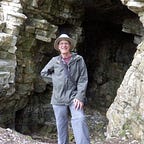Living, Learning, Evolving
How do we as human beings come to know and understand the complexities of the natural world in which we are situated?
And how does the way in which we do this affect the way in which we live? And how does the way in which we live affect the way in which we do this?
Ultimately these questions come down to the question of how we explore the nature of reality and how we learn from our findings in a cumulative process of evolutionary transformation.
How much do we rely on the learnings and teachings of our predecessors embedded in what we are told and taught? How much do we explore afresh for ourselves?
And how do we report our findings to ourselves and others? Do we do this as an ongoing iterative and re-iterative process in which our forays, discoveries and mishaps are put on record as and when they happen? Do we wait until some endpoint is reached, which enables us to stand back as an objective, ‘third- person’ observer and single out with hindsight those steps along a ‘line of best fit’ that seem to have brought us to our destination? As if these steps had been made deliberately, with foresight, regardless of our subjective feelings, experiences and uncertainties.
It is that back-projection of ‘post-hoc rationalisation’ and its concomitant ‘economical attenuation of the truth’ that continues to bedevil much modern academic — and especially scientific — enquiry, reporting and teaching. It results in a profound misunderstanding of evolutionary processes, which confuses material consequence with natural cause. It has contributed enormously to our modern scientific, psychological, social and environmental crisis in which we live at odds rather than alignment with our true nature.
How can we remedy this misalignment?
Quite simply, I think we can do so by combining our innermost, first-person awareness of how it feels emotionally to inhabit a living body continuously experiencing changing circumstances along with our growing third-person knowledge of material form in the natural world about us. This takes us directly to an awareness of our selves, both individually and collectively, as receptive-in-responsive beings as dynamic natural inclusions of — not exceptions from or conflations with — our contextual neighbourhood (For fuller explication see https://admrayner.medium.com/self-in-neighbourhood-neighbourhood-in-self-the-comprehensive-situational-awareness-of-natural-ae62ede623bf).
We can then appreciate comprehensively what no purely third-person or first-person perception will recognise:- the mutually inclusive, co-creative, receptive-responsive relationship between intangible spatial stillness and energetic motion in the being, becoming and evolutionary diversification of all material bodies, including our own.
And this appreciation opens the way for a more honest, compassionate, considerate and creative way of life than many of us currently experience. Let’s not allow our adherence to the dictates of the post-hoc rationalisation of objectivistic science and the vagaries of subjective unboundedness to continue to obscure the open-ending path from here on.
Let’s make the move from exclusive ‘self-delusion’ to dynamical ‘self-inclusion’ in Nature.
For further exploration of natural inclusion, please visit http://www.spanglefish.com/exploringnaturalinclusion
— — — -
NB I was inspired to prepare this essay by the remarkable complexity science- and systems theory- oriented work of Louie Gardiner
